

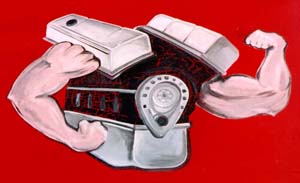
|
This article, in slightly different form, appeared in Folk Art Messenger, Summer 1998, published by the Folk Art Society of America.
The key thing about folk art in the city is that if you happen to live in one, you can find it by opening your eyes and looking around. Some threads of creativity in the urban fabric are more visible, some are more interesting, and some less so. But the rewards are like those associated with country-made folk art: displays of imagination, resourcefulness, unexpected expression and idiosyncratic vision. Indeed, the difference between urban and rural folk artists is sometimes just a matter of Zip code. The self-taught, artistically solitary carver or painter working out of an apartment or a postage-stamp backyard to create works of art for the pleasure of it, or to get across some compelling message, is a figure no less familiar in the city than the country. William Dawson, who lived in a high rise on Chicago's North Side, drew and carved plenty of animals along with his architectural reliefs and totems, just like Jimmy Lee Sudduth, who lives in small-town Fayette, Alabama, paints cityscapes alongside his alligators and log cabins. The UFO drawings by New Yorker Ionel Talpazan are as eccentrically visionary in their way as the heavenly landscapes Howard Finster has produced in Summerville, Ga. |
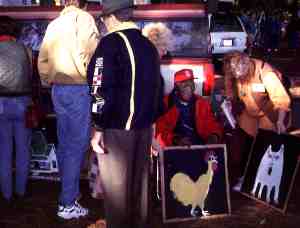
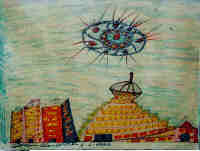
|
|
Similarly, where an S.L Jones might come to public attention after hauling his work to a county fair, a Mose Tolliver can be discovered lining up paintings in his front yard near downtown Montgomery, Ala., or a Joseph Yoakum finds an audience by hanging his visionary landscapes in a South Side Chicago storefront. Lee Godie found an audience via her persona as a specifically urban type, the bag lady. For years Godie spent her days on Chicago's Michigan Avenue, disheveled but stylish, showing and selling her drawings to passersby. In a sense, Godie was one of the country's most accessible folk artists. Michigan Avenue is the city's main shopping street, and Godie - unless you stumbled onto her bad side - priced her work quite affordably. Over the years she developed a coterie of friends and admirers in the city's art community, though only in her last years did she finally leave the streets. There are street artists like Godie in most cities -- some well-known, like New Orleans' Sister Gertrude Morgan, some never rising much out of obscurity. The erotic drawings that Sal Merchino sold at Chicago's downscale Maxwell Street flea market wound up in the inventory of New Orleans' Gasperi gallery, and one even made it into the book "Folk Erotica," but the drawings are more widely known than Merchino. Several Chicago collectors own the heavily patterned figure drawings that one clearly self-taught artist used to sell around the Art Institute, but they don't know his name. There is a whole class of artists whose obscurity was not interrupted in their lifetimes. Milwaukee's Eugene Von Bruenchenhein was a prolific creator whose work, especially his photography, has a definitely urban feel, and whose massive achievement remained unnoticed until after his death. The identity of the Philadelphia Wireman, whose sculptures of wire wrapped around found objects were found in the trash, is still unknown. Achilles Rizzoli created a fantasy city that was seen only by a few neighbors until after his death. And then there is Chicago's most important contribution to outsider art, Henry Darger. His vast body of work was unknown and saved only by the serendipitous interest of his landlord, photographer Nathan Lerner, after Darger entered a nursing home. Darger created his visionary universe in a tiny rented room in a small apartment building in the now-gentrified Lincoln Park. These artists are relatively inconspicuous in the urban folk art landscape. There are far more public layers, starting with the most ubiquitous form of vernacular expression - graffiti. This isn't necessarily the most interesting genre of folk expression, but it's everywhere. I can walk out to my alley in Chicago and see gang scrawls, or on the El downtown ponder the now-nearly universal graffiti style pioneered in the New York subway. These examples of untutored, in these cases outlaw, expression have their adherents, but they've developed into cliches as they've become ubiquitous. The same can be said for many of the murals that started appearing in American cities in the late 1960s. A lot of these wouldn't qualify as folk art under most definitions, since they were created by (or under the close direction of) trained artists. Many newer murals, like increasing numbers of hand-painted signs and other urban forms of expression, are executed in the same cliched spray-paint style that makes so much graffiti so much less than interesting. Nonetheless, you're still liable to come across interesting exceptions. There's a drug store in Chicago that boasts a very folky-looking mural of a pharmacist at work. On the railroad embankment along Hubbard Street northwest of the same city's downtown there is a long line of murals dating from the mid-70s. A variety of images are on display, including panels illustrating underwater life and a number of American Indian-inspired pictures. |
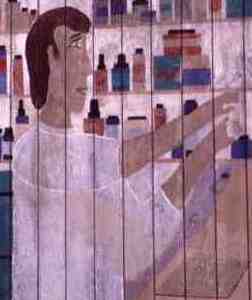
|
|
Just as public but not as common are more traditional folk-art environments. The classic city environment is of course Simon Rodia's Watts Towers in Los Angeles, which, like so much art in this genre, was nearly lost before interested parties intervened to preserve it. By most accounts Rodia was something of a curmudgeon, which also could characterize the builder of the "Cross House" on Chicago's near Northwest Side. The front of his tiny side-street bungalow is a forest of crosses and plaques crowded into a very urban setting, Many of the crosses have celebrity's names on them, some dead, some still living. On the other end of the spectrum is Paul Hefti in La Crosse, Wisc., who loves showing visitors around the garden of hand-crafted whirligigs that fills his yard. Similarly, it's clear that Joe "40,000" Murphy enjoyed showing off his environment, which, like the Cross House, represented a major tribute to a generation of entertainers. Unlike the Cross House and other rural counterparts, Murphy's environment was interior, covering the walls and ceilings of his three-flat house and five-car garage on Chicago's South Side. A fixture at public events for decades, this professional usher encapsulated Chicago's mid-century history in his photo-and-collage environment. His walls and ceilings were populated with movie stars, athletes and politicians, typically being escorted at public events by a jovial Joe Murphy. He called the house the Murphy museum, penning in his own decoration and notes to many of the pictures. |
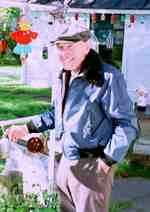
|
|
Interior environments are not uncommon in the city. A former proprietor of Miami's Bottle Cap Inn covered the interior of his bar, including a piano, with bottlecaps. Joseph Furey covered the inside of his apartment in Brooklyn's Park Slope with shells, buttons and other items. Furey's walk-up environment, though widely publicized and, for a while, cared for by sympathetic tenants, ultimately was destroyed by the building's owner. Under less immediate but nonetheless serious threat is what collector and dealer Aron Packer calls Chicago's anonymous lakeshore art gallery. These are stone carvings that are intermingled with more traditional graffiti and the occasional piece of public art along the city's long lakefront. It's material you wouldn't be likely to notice unless you're in the habit of looking down at your feet rather than over the water as you stroll along the lake. Some of the carvings are decades old, some brand new. There are lone initials, and sometimes surfaces dense with dozens of them. There are a number of animals, Indian heads, fish and other conventional subjects. There are several elaborate Mexican-influenced tableaus by a carver who is still active. And there are bizarre images, like the three crosses of Calvary captioned "Dead Ha Ha." |
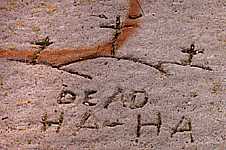
|
|
This "gallery" has been carved into the stone steps and retaining walls by generations of creators. It's anonymous folk art at its purest, free for the looking. And though it seems like the most permanent of the city's vernacular art, much of it is likely doomed when the government gets around to the major lakefront restoration it's planning. Often as anonymous as the lakefront relief carvings, and completely fly-by-night, is the crackpot expression that can turn up in personal posters and stray leaflets. The ranting is often religious, though sometimes political and on occasion totally incoherent. These aren't the commercially printed leaflets that street preachers pass out, but rather hand-made broadsides against all manner of wickedness. A great example is 77x7, whose broadsides - hand-drawn with marker on scavenged nightclub posters -- show up stapled to stoplights and utility poles all over Chicago. It's text, but rendered with enough panache to display a distinct visual style and enough fury to demonstrate the transformative power of words. While the content is sufficiently over the top to inspire discomfort, it's still a fascinating dose of personal expression for anyone happening to be paying attention. |
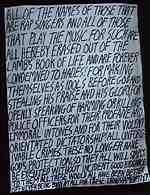
|
|
It's clear the intention behind these missives wasn't to make art, yet the compulsion to communicate, the determination to express something no matter what, would well serve any artist. The spiritual rage that powers these visions -- however bizarre the messages and however seriously one may refuse to take them -- achieves a kind of transcendence few artists can aspire to. Another example of crackpot street art is a thick sheaf of photocopies passed out on Michigan Avenue several years ago and signed US Beings PTL. The poetic announcements seem more incantatory than imperative, and the combination of typewriter text and simple drawings embody a pure, raw form of strangeness. The message is not entirely clear, beyond a condemnation of the deadness of television. While you may remain unconvinced, or even uncomprehending, you're not necessarily unmoved when faced with this awful passion. Emotion overflows from this work, putting it at the opposite end from perhaps the most accessible example of urban folk art -- the signs that line most city's downscale commercial districts. They can range from primitive hand-lettered placards to backlit plastic boxes that on occasion put an eccentric image on a standard-issue commercial sign. These small masterpieces of prosaic art -- in which mostly anonymous artisans lovingly render a gyros or a car motor or a hairdo -- put transcendence on the street corner. Ranging from naturalistic to surreal to obsessively intricate, they are modern-day icons, literally: a kind of devotional image produced by anonymous artisans of greatly varying skill to bring the faithful into communion with the object of their fervor. The expression can be especially eloquent when the subject matter is fast food. Surrounded by flames on a signboard altar, a hunk of gyros meat can be almost spiritual. The language is commercial, but the imagination can remain personal, even visionary, especially when artists struggle to express their messages without much regard to aesthetic standards. The E&T Muffler man, for example, is less a commercial mascot than an ominous dream figure of indeterminate origin. Visionary or not, it's easy to take these signs for granted until a favorite image suddenly disappears when a business closes or a fašade is upgraded. Chris Gyros was doomed by a valuable location. George's once featured a remarkable gyros anatomy, displaying the inner workings of a sandwich in all their glory. Now there's a sign that's new, but without character. That's one of the risks with any folk art, that passing time will fade or even obliterate it. All you can do is appreciate it while you can, perhaps even document it, and hope it represents a tradition that is not quite over. |
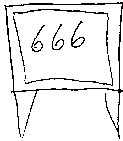
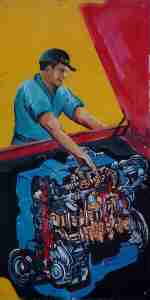

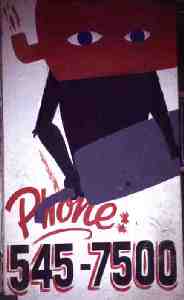
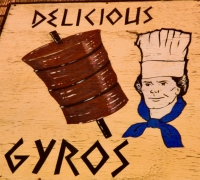
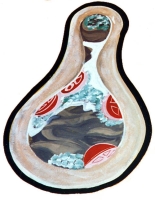
|
The Latest Stuff | Roadside art | Outsider pages | The idea barn | About | Home
Copyright Interesting Ideas 1998